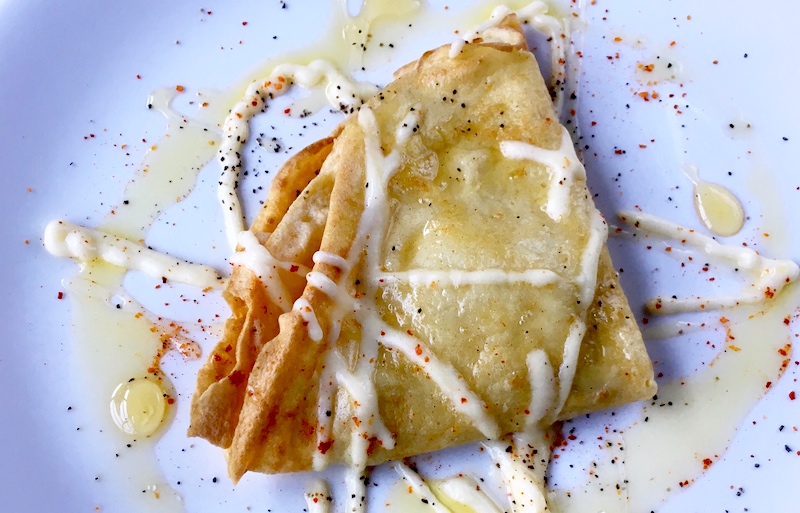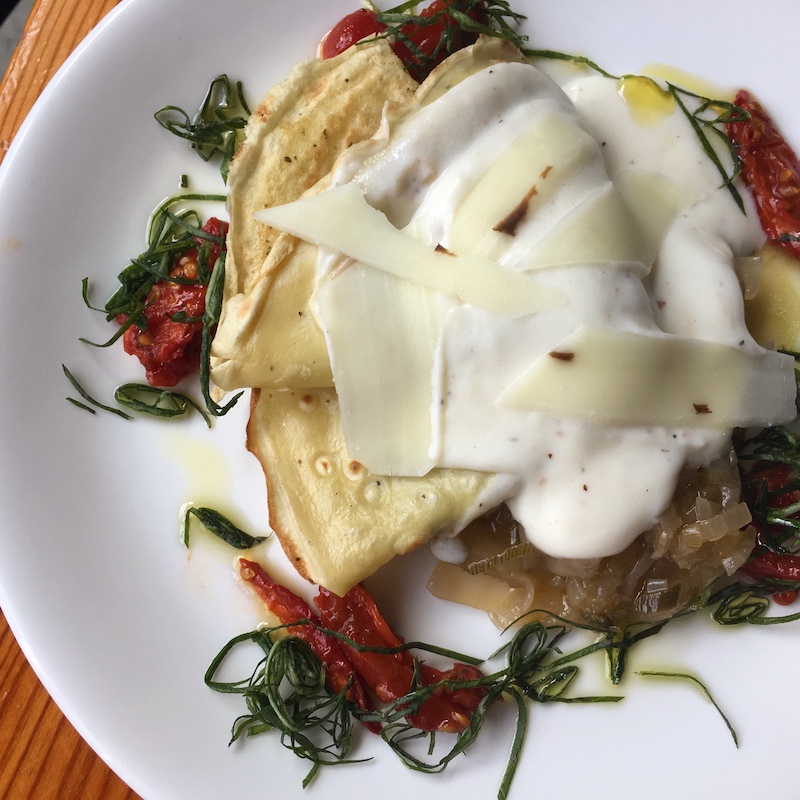
Ciaffagnoni: Delicate Crepes from Tuscan Cowboy Country
Elizabeth Petrosian, co-owner of Portland's (tiny) palace of Florentine cuisine, Burrasca, is a fabulous writer, and when I asked if she'd share their Portland Dining Month recipe for ciaffagnoni—one of three courses for $33 during the month of March—she agreed, and then offered to write the whole post. I was thrilled! Get their full Dining Month menu.
Italy isn't really a country; it's a patchwork of regions held together by a common respect for carbohydrates. But more than this, Italy is a tight, often rivalrous amalgamation of micro-regions. Take Tuscany, for example (my adopted home for 12 years). There's the postcard Tuscany you're all familiar with: the burnished gold, cypress-dotted mounds of the Val d'Orcia; the undulating hills of vineyard-strewn Chianti; the smug stones of Florence and the empty-headed starlet that is Cortona. With a land area of just under 9,000 square miles—about the same size as New Jersey—it's a remarkable solar system of mico-regional planets, each spinning in its own gastronomical orbit, all revolving around one Tuscan culinary sun.
There's the taciturn Mugello, peppered with ochre-colored Medici hunting villas, with its neighbor Emilia-Romagna sitting just over the spine of the Appenine mountains and casting its long glance over the local cuisine; the heavily forested, chestnut-loving Casentino; the rugged Lunigiana, playing mountain-bred, culinary Romeo to next-door Ligurian Juliet; there's the impossibly lovely Etruscan coast, with many of its gastronomic tradtions—as is to be expected—rooted in antiquity. Then there's the Maremma.

The Maremma is Tuscany's Wild West: a no-nonsense-talking, game meat-loving region of rustic beauty known for longhorn cattle, butteri (Maremman cowboys), hunters, and winemakers who know how to wrangle grapes in iron-rich soil kissed by Tyrrhenian sea breezes. It's the place to eat cinghiale (wild boar), either stewed with mele cotogna (quince) or with small black local olives and red wine. With its rolling hillsides and pastureland, it's also the place where fresh, deeply flavored sheep's cheese is a common ingredient.
If you're lucky enough to find your way to the small hill town of Manciano in the Maremma, you can eat tortelli mancianesi and be much an improved person for having eaten them. Every part of Tuscany has its version of tortelli, but in Manciano they exalt the excellent local sheep's ricotta in a filling along with spinach and a touch of cinnamon, dressing the pasta with fine local Chianina beef ragù. Likewise, sheep's cheese stars in another specialty of tiny Manciano: ciaffagnoni. These are savory crepes traditionally adorned with ricotta or pecorino. Leafy greens or even a bit of fruit are often added, as in this version we're currently serving at Burrasca all March long as part of our Portland Dining Month menu: the crepes are filled with ricotta and diced pear, along with a whisper of nutmeg and cinnamon, then folded into fagottini and topped with a sauce of pecorino toscano, drizzled with honey and sprinkled with chili and black pepper.
Contrary to what you might believe, crepes, or crespelle—a gift from Catherine de' Medici to France—are as Italian as Vespas, four-hour lunches, and crippling bureaucracy. Legend has it that they were willed into being as pilgrim-fodder by Pope Gelasius I in the late 400s, an early example of peninsular ingenuity when it comes to paltry ingredients. Regardless of origins, Manciano has a way with crepes that is, well, celestial.
As mentioned, ciaffagnoni lend themselves to a variety of fillings; we've also served them filled with ricotta and Swiss chard, topped with a bit of béchamel and truffled pecorino toscano, and served over tropea onions in dolceforte and oven-dried tomato. They make lovely appetizers. Use your imagination!
Ciaffagnoni with Ricotta Filling and Pecorino Sauce
Ingredients to make about 2 dozen crepes.
For the crepes:
4 eggs
1 c. (150g) all-purpose flour
1 1/4 c. (300 ml) warm water
Pinch of salt
For the filling:
1 c. (250g) fresh ricotta
1 c. (250g) ricotta salata (or you can use all fresh ricotta if you prefer)
2 whole eggs, plus 2 yolks
1/2 c. (60g) grated parmigiano-reggiano
1 D'Anjou pear, diced small
1 tsp. freshly grated nutmeg
1/2 tsp. cinnamon
A bit of salt and black pepper
For the sauce:
1/2 c. (100g) fresh young (not aged) pecorino, diced—Tuscan preferred but we won't hold it against you if you go rogue
3/4 c. (80g) grated parmigiano-reggiano
3 tsp. (10g) corn starch
1 3/4 c. (400 ml) whole milk
3 eggs
Additional ingredients:
Honey, red chili pepper, black pepper
The crepe batter has to rest for a half hour, so you can get the filling and sauce ready in that time. You'll need a 6" or 7" non-stick pan to make the crepes.
To make the crepes: Whisk the eggs, add warm water little by little, then add flour little by little. Add salt and whisk until smooth. There should be no lumps. Let batter rest for a half hour.
Preheat the oven to 350°.
Over medium heat, warm your pan and grease it lightly with olive oil or butter. Ladle in just enough batter to cover the pan surface—don't make it thick; the crepes should come out very thin. When it begins to bubble and detaches from the pan, flip it; it should have a light golden-brown color. Cook other side until lightly colored. Make sure to leave them moist, not crisp, otherwise they'll crack! Set aside.
Prepare the filling: Simply mix all the filling ingredients well.
Prepare the sauce: Put the sauce ingredients into a bowl and blend with an immersion blender. Then, in a small pot on the stove, bring to 170 degrees, stirring constantly, and remove immediately once the temperature is reached.
Assembly: Take a crepe and lay it flat. Place some of the filling (don't put too much or overstuff it) on 1/4 of the crepe and then fold the crepe over it into a half circle. Then fold it over again into a triangle (one-fourth of the original shape). Once you've folded all your crepes, place as many as you can onto an oven sheet pan and bake for 4 to 5 minutes. They'll crisp a bit at the edges.
Drizzle the finished crepes with the pecorino sauce, some honey, and a tiny bit of red chili pepper if you like a bit of a kick, and/or a bit of freshly cracked black pepper.